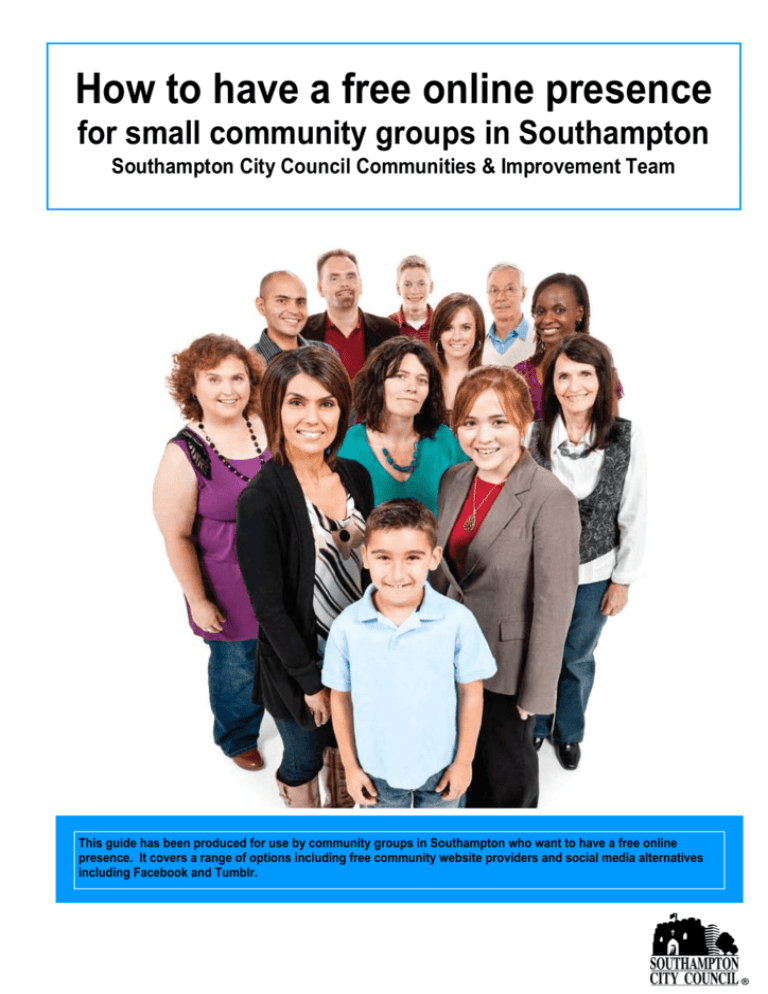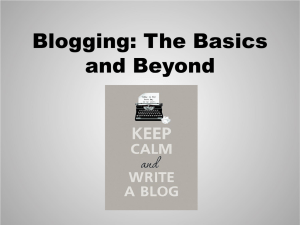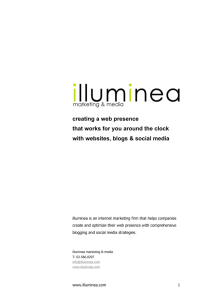How To Have A Free Online Presence 2013
advertisement

How to have a free online presence for small community groups in Southampton Southampton City Council Communities & Improvement Team This guide has been produced for use by community groups in Southampton who want to have a free online presence. It covers a range of options including free community website providers and social media alternatives including Facebook and Tumblr. How To Have A Free Online Presence Without Needing Or Paying For A Web Designer. Nowadays almost every organisation either has or wants a presence on the internet and luckily this doesn’t mean you have to pay large sums of money for a web designer; in fact many organisations now have their place on the web without it costing them a penny. The days of organisations being limited to having a website with pages that contain information which isn’t updated frequently are now gone. More and more organisations realise that having some form of web presence where they can update their information regularly on their site is freely available. They are turning to social networks and / or blogs so they can have their own web presence, and not only has the cost fallen to zero for having some form of web “site”, but it’s also never been easier. As more and more organisations are realising that it’s important to engage with potential customers, volunteers and like minded organisations, a blog or a social media space on the internet can be more important nowadays than a single traditional information type “static” website which is can be costly to initially set up, but also costly in maintaining or having any changes made to it. So what is a “static” web site? Static web sites can be described as mainly focused on showing permanent information ie www.southampton.gov.uk/yourcommunity. The content of each web page is usually fixed and does not change unless it is edited and republished by the web designer or web master. Static websites are usually small and only contain a few pages, e.g. About Us, Contact Us, Our Services. It used to be that static web sites were the simplest way to showcase your service or product online, but with the availably of blogs and social networks, this is no longer the case. Generally speaking, as blogs and social network sites are so easy to use and update, the need for employing the services of a web designer is less common than it used to be. Social Networks We’ve all heard of Facebook and Twitter for engaging with others in social networks, however there is still a need for a “base” on the internet that you can call your own and running a blog in conjunction with other social media sites you may have is a great way of getting people to your “site” where you have complete control over your information, design and any updates needed. It’s also relatively easy to point your domain name, (for example “www.southampton.gov.uk”) to your blog site with an easily recognisable domain just as you would with a static website. Social networks, ie Facebook, are comprised of pages or groups people can join where they share information such as news, photographs, links and even videos. Facebook - members can share information with like minded people and other organisations that share the same interests. You can think of being on Facebook as having your own mini website which is your profile page from where you can engage with other users in your chosen network. Blogs Web logs (or “blogs” as they are commonly called) are types of web sites where information can be updated and listed in chronological order if needed and very easily updated without the need of employing a web designer. Blogs also have the facility where readers or visitors to the site can engage and leave comments. One reason why organisations are opting to have blogs as opposed to a traditional websites is the fact that search engines, mainly Google love blogs, as blogs tend to be updated more often and search engines often return to blogs to check regularly for new posts. This means your blog usually has more chance of showing up if someone is searching for it as opposed to finding a website which is seldom updated. Blog owners also have the advantage of being able to engage with readers who leave comments on the blog as well as being able to post new updates from more or less anywhere with an internet connection without the need of having a web designer having to make any changes or post updates. Generally speaking, posting updates to a blog is as easy as filling in a simple online form and it’s also simple to amend any posts or even delete them if you change your mind; something that’s more difficult with a static website. As mentioned at the start of this article, most blog platforms are completely free to set up and don’t require web designing experience either. The majority of blogs are also very easily customisable and if you change you’re mind with regards to your blog’s design, you can change it without the need of having to pay for the services of a web designer. There are many blog platforms to choose from and deciding upon a blog platform is usually a matter of personal preference, however, here’s a list of blog platforms to consider with some information which you might find useful in deciding which one to opt for. Wordpress – Currently there are 2 main types of Wordpress blogging platforms available; the free online version – www.wordpress.com and the downloadable version of Wordpress from www.wordpress.org The .org version of Wordpress is one which you download and then install to your own server. This is called “self hosting”. The disadvantage of this version is that you will need a relatively good level of technical skills to install this onto a server. The advantages of this .org version is that there are lots of “plug ins” available for this version of Wordress which can add a variety of customisations to your blog. The .com version of Wordpress is the version which stays online with Wordpress and all you simply need to do is complete an online registration form and then you simply log in to your blog. The advantage of this version is that it stays on the servers of Wordpress and you have nothing to worry about with regards to hosting your blog. This version of Wordpress is also customisable with various themes and you can also upload your own graphics to further customise your blog. One disadvantage however of this version of Wordpress is that you cannot install “plug ins” like you can with the .org version, however for most users this isn’t an issue. Blogger – This blogging platform is available through Google and if you have a Google email account you can open a Blogger (or .blogspot) account. If you haven’t got a Google (or Gmail) account, all you need to do is simply sign up for one and then you can open a Blogger account. As with Wordpress, Blogger is customisable with various themes and just as easy to use. Blogger is hosted on Google’s servers and so it’s simply a case of logging in to your account to post updates. Also like Wordpress, Blogger is completely free to use. Tumblr – Tumblr has seen a massive rise in popularity recently and has as many users as the popular Wordpress blog platform including some big names companies. Tumblr allows users to post text, images, videos, links, quotes and audio to their blog. As with Twitter users can choose to follow other users so that they see their respective updates. Even though Tumblr may initially seem “lightweight” compared to other blog services, it can very easily be tailored with any of the multitude of customisable designs, or themes available from community type to more corporate looking designs. Apart from the 3 blog platforms already mentioned, there are plenty of other blog platforms available including LiveJournal and Typepad which you may have already heard of, however choosing a blog hosting platform is often largely a matter of personal choice. Still need a static traditional web site? After having considered the alternatives to traditional static web sites, you may decide that social networks and blogs are not for you as you don’t often need to change the information on your web site or you don’t have the resources to engage on social networks. If this is the case, then will you need the services of a web designer? Probably not. There are services available on the internet with which you can “build” your own simple website. One such service is the “BT Community Website Builder” at http://www.btck.co.uk which is a service for charities and for not for profit community groups. By using various already installed templates and “building blocks”, online web site builders can offer an alternative to paying for a web design service. Apart from BT’s web site builders, there are many other alternative services available including Google Sites and E-voice which offer a free and easy way to create and share web pages. – http://sites.google.com and http://www.e-voice.org.uk/. Summary With so many free options available for having a web presence for your organisation or community group, including blogs, social networks and site builders, the need for having to spend money on web design services is far less common than it used to be. When you add up the cost of having a web site initially designed, together with the cost of having any updates made or maintenance to your site, the cost saving benefits, versatility and ease of use of alternative options such as social networks, blogs and site builders is probably something that your organisation cannot ignore for too long. This written information is available on request in other formats or languages. Please contact communities@southampton.gov.uk for help. www.southampton.gov.uk/yourcommunity Designed and produced by Southampton City Council 06.11.23081





